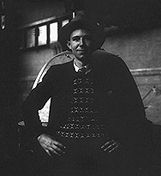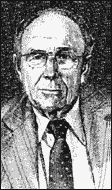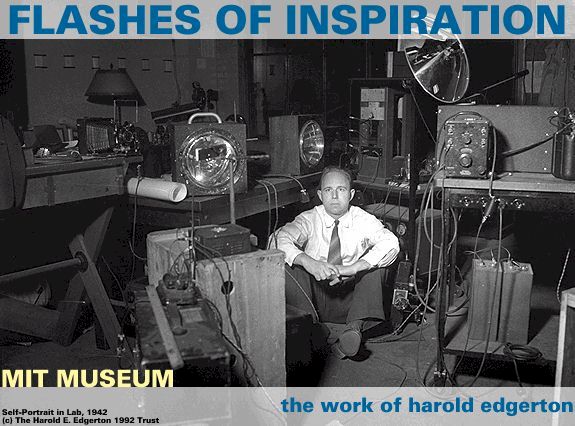History
of High Speed Photography
|
 Harold
"Doc" Edgerton was a pioneer in the High Speed Photography
field, and was the first photographer credited with attempting it.
Pioneering research in stroboscopic photography by Harold E. Edgerton
was the foundation for the development of the modern electronic speed
flash. Both the Shutter-Beam and the ADDjust A Sec were inspired
by his beginning works in this field. Harold
"Doc" Edgerton was a pioneer in the High Speed Photography
field, and was the first photographer credited with attempting it.
Pioneering research in stroboscopic photography by Harold E. Edgerton
was the foundation for the development of the modern electronic speed
flash. Both the Shutter-Beam and the ADDjust A Sec were inspired
by his beginning works in this field.
Born in Fremont,
Nebraska, Edgerton graduated from the University of Nebraska and the
Massachusetts Institute of Technology. He joined MIT as a research
assistant in 1927, became a professor in 1948, and was Institute
professor emeritus from 1966 until his death.
|
Edgerton earned
international recognition for his achievements in the related fields
of stroboscopy and ultra-high speed photography. The electronic speed
flash his research spurred is important to science and industry as
well as routine photography. He originally perfected the use of
stroboscopic lights in both ultra-high-speed motion and still
(stop-motion) photography capable of revealing operations which move
at speeds beyond the perceptive capacity of the human eye (i.e.,
bullets in flight, light bulbs shattering, etc.).
Edgerton also made significant contributions to underwater exploration
and worked aboard the ship Calypso with Jacques Cousteau and his crew
in explorations of sea floors in the Mediterranean and other
locations.
Edgerton was one of the founding partners of EG&G, Inc. (formerly
Edgerton, Germeshausen and Grier), a company specializing in
electronic technology, and also helped organize and build the New
England Aquarium in Boston.
|
 Professor
Emeritus Harold E. "Doc" Edgerton, 86, died January 4, 1990,
after suffering a heart attack at MIT. Born in Fremont, Nebraska, he
graduated from the University of Nebraska in 1925 with a degree in
electrical engineering. He came to MIT to complete his graduate work
(SM '27, ScD '31) and joined the faculty in 1932. Professor Edgerton
had been affiliated with RLE since its inception in 1946. His initial
interest in stroboscopic photography stemmed from his doctoral
research, and paved the way for many industrial applications,
including night-time aerial and underwater photography. Collaboration
with two of his students, Kenneth J. Germeshausen and Herbert E.
Grier, resulted in formation of the company EG&G, which helped to
develop the instrumentation and applications for high-speed strobe
photography. Professor Edgerton also participated in the
archaeological "photo excavation" of many historic
underwater wrecks and lost cities. His work in this area led to the
development of side-scan sonar technology. Professor Edgerton was the
recipient of many distinguished honors and awards, the most recent
being the National Geographic Society Centennial Award and the
National Medal of Technology in 1988. In addition, he was a member of
many organizations and professional societies. Professor
Emeritus Harold E. "Doc" Edgerton, 86, died January 4, 1990,
after suffering a heart attack at MIT. Born in Fremont, Nebraska, he
graduated from the University of Nebraska in 1925 with a degree in
electrical engineering. He came to MIT to complete his graduate work
(SM '27, ScD '31) and joined the faculty in 1932. Professor Edgerton
had been affiliated with RLE since its inception in 1946. His initial
interest in stroboscopic photography stemmed from his doctoral
research, and paved the way for many industrial applications,
including night-time aerial and underwater photography. Collaboration
with two of his students, Kenneth J. Germeshausen and Herbert E.
Grier, resulted in formation of the company EG&G, which helped to
develop the instrumentation and applications for high-speed strobe
photography. Professor Edgerton also participated in the
archaeological "photo excavation" of many historic
underwater wrecks and lost cities. His work in this area led to the
development of side-scan sonar technology. Professor Edgerton was the
recipient of many distinguished honors and awards, the most recent
being the National Geographic Society Centennial Award and the
National Medal of Technology in 1988. In addition, he was a member of
many organizations and professional societies.
|

His now famous work
includes the balloon popping picture on the left as well as many
others. See the links page for
other sites with his work on them.
|

Seen here in his lab in 1956, he
inspired many to follow in his footsteps, and has forever changed the
world of photography.
|
|
Have some information about Doc Edgerton I missed? Email
it to me.
|
|

|
|
Print this page
|
|
|
|
This
site is meant to be viewed in frames format.
If you have reached this page
outside of it's frames format click here to obtain the frames view. |